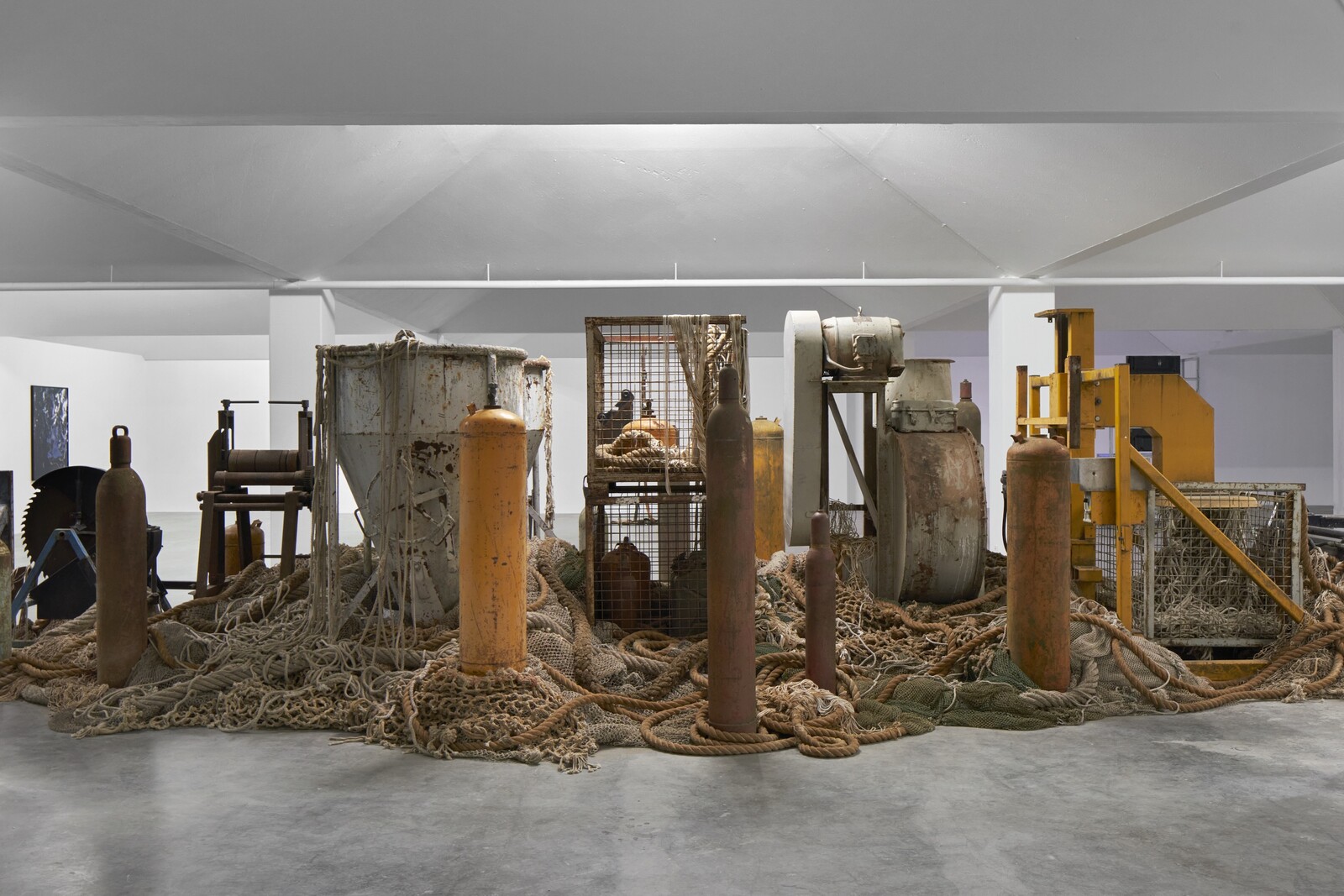The subterranean rooms of artist-run space Simian, in Copenhagen’s Ørestad district, could easily be mistaken for an underground bunker after the industrial apocalypse. Ørestad itself is a curious reminder of failed human design: an eerily deserted hangover from a bold urban plan to transform this area of wetlands on the edge of a nature reserve into a metropolitan center with gleaming glass buildings and a floating metro line. In the bowels of an old bicycle lockup, it feels as if the only souvenirs of the old industrial world are artworks by Toke Flyvholm, Yuri Pattison, Naïmé Perrette, and Lucie Stahl.
Perrette’s documentary-style video Both Ears To The Ground (2021) is the engine of an exhibition that addresses the climate crisis. Projected on a wall in an intimate space within the first room of the gallery, the video focuses on the town of Berezniki in the Ural mountains and establishes the themes of collective amnesia and aestheticization that run through the exhibition. Once a beacon of Soviet industry, the town is now blighted by sinkholes created by the potash mines beneath.
For residents, the sinkholes—warmly referred to by nicknames such as “the grandfather”— are a part of daily life. We are introduced to a resident compensated for the loss of his home who sees no need to discuss it further, and a woman who refuses to believe she could ever fall into a sinkhole. As Perrette plunges into the cavernous spaces below the town, the artist reveals troubling ironies: when one miner expresses his eagerness to keep digging (“movement is life”), it seems inevitable that he will contribute to the destruction of Berezniki. Nonetheless, Perrette does not cast judgement, but highlights a defiant community getting on with the business of living. A local theatre troupe continues to entertain the mine workers, and Perrette does not dictate whether the viewer should feel frustrated, sympathetic, or impressed by its blithe attitude to ecological disaster. Alongside an attempt to quantify the environmental impacts of capitalism, the video suggests, is the “amount” that humanity is willing to ignore—or able to understand—in the face of the climate crisis.
The remaining artworks are displayed in the gallery’s much larger main room, the concrete expanse of which is interrupted only by tremendous white columns. Flyvholm’s installation of industrial parts, placed at the center of the gallery, could have been pulled from the Berezniki mines. The objects that comprise Caretaker (2022)—ropes, cages, canisters, tankers, and buckets—are taken from a variety of dismantled machines that have fallen still. By contrast, Stahl’s series of photographs of an abandoned oil field in the Qark Fier region of Albania (“The Burrows,” 2022) picture the black gold that might once have flowed through Flyvholm’s mutant machine. The oil is framed by the two-dimensional image, an oozing mess now contained. Light is captured forming beautiful, abstracted patterns. In aestheticizing the surface of the oil, Stahl also draws attention to our readiness to see isolated detail over the wider context of ecological destruction.
Pattison’s installation sun_set provisioning (2020–21) employs a similarly mesmerizing aesthetic. Displayed on digital screens mounted on aluminum brackets, the videos draw the viewer towards an endless horizon between sea and sky. The palette of two digital seascapes, conjured using game engine software, is continually transformed by real-time atmospheric conditions, such as temperature and air quality, from a monitor attached to one of the screen’s aluminum frames. On a bright winter’s day in Ørestad, the screens are stained bubblegum pink. The artificial colors of the ocean are radiant, as the motion of the undulating waves is hypnotic. In a recent interview at The Douglas Hyde Gallery in Dublin, Pattison cited art-historical sunsets that have responded to moments of apocalyptic change, as with J.M.W. Turner’s Romantic landscapes, given that their light and texture attest to the air pollution of England’s early industrial era.1 Pattison’s digital simulacrum of nature is, also, at once calming and nightmarish: a twilight without end. The video-game aesthetic distances the viewer from the material world even as it displays information on the parlous state of our environment. The viewer is left to tussle with how much of this information they are willing to accept.
“Yuri Pattison in conversation with Georgina Jackson,” The Douglas Hyde (July 2021), https://thedouglashyde.ie/artist-talk-yuri-pattison/#0.






